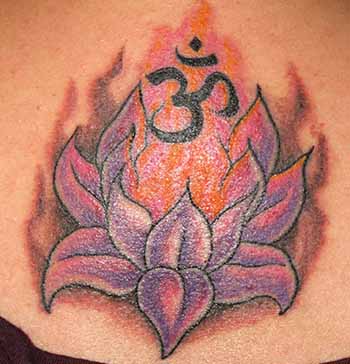A talisman is an object which is believed to contain certain magical properties which would provide good luck for the possessor and possibly offer protection from evil or harm. The word comes from the Arabic word Tilasm meaning "completion, religious rite".
Amulets and talismans are often considered interchangeable despite their differences. An amulet is an object with natural magical properties, whereas a talisman must be charged with magical powers by a creator. The talisman can be created for a specific purpose while an amulet can be used for generic purposes such as protection, averting evil, or attracting good luck.
In the alchemy of time and consciousness, talisman and amulets have always been programmed as tools of power and protection in lieu of our own limited abilities that most of us feel we should genetically possess. In other words, they protect us while we are experiencing in physical reality, our souls knowing that we are inherently light and consciousness, and about to return to that state of being.
Archaeologists have discovered an extremely rare and unusual ancient stone amulet in Jerusalem that could change our understanding of reading and writing in antiquity NY Post - September 3, 2024

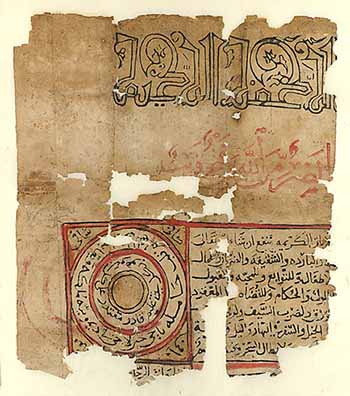
Talismanic Scroll from the collection of the Metropolitan Museum of Art
This object, an 11th century "Talismanic Scroll," was discovered in Egypt and produced in the Fatimid Islamic Caliphate (909-1171 C.E.) It resides in the collection of the Metropolitan Museum of Art (New York, NY) along with a number of other Medieval Islamic amulets and talisman that were donated to the museum by the Abemayor family in 1978. About 9 inches by 3 inches in size, the miniature paper scroll contains a combination of prayers and Qur'anic verses, and was created for placement in an amulet box.
This block print bears Kufic, the oldest calligraphic Arabic script, as well as "Solomon's Seal," a star with six points has been identified in a large number of Islamic art pieces of the period. Block printing was utilized as a technique through which to mass-produce talisman scrolls, hundreds of years before block printing was incorporated into European societies.

The Seal of Solomon, also known as the interlaced triangle, is another primeval talisman and amulet that has been commonly used in several religions; but though it is said to have been the emblem by which the wise king ruled the Genii, it could not have originated with him as its use dates back much further than the Jewish Dispensation.
As a talisman it was believed all-powerful, being the ideal symbol of the absolute, and was worn for protection against all fatalities, threats, and trouble, and to protect its wearer from all evil.
In its constitution, the triangle with its apex upwards represents good, and with the inverted triangle, evil: the triangle with its apex up being typical of the Trinity that exists in several religions; in India, China and Japan, its three angles represent Brahma, Vishnu, and Siva, the Creator, Preserver, and Destroyer or Regenerator; in Egypt it represented Osiris, Isis and Horus; and in the Christian Church, the Holy Trinity. As a whole it stands for the elements of fire and spirit, composed of the three virtues (love, truth, and wisdom).
The triangle with its apex downward symbolized the element of water, and typified the material world, or the three enemies of the soul: the world, the flesh, and the Devil, and the cardinal sins, envy, hatred and malice. Therefore, the meaning of the two triangles interlaced, is the victory of spirit over matter, and at the beginning of our present civilization was believed an all-powerful talisman and amulet, especially when used with either a Cross of Tau, the Hebrew Yodh, or the Egyptian Crux Ansata in the center.
All the traditional magical schools advise that a talisman should be created by the person who plans to use it. They also recommend that the person making the talisman must be familiar with all the symbolisms connected to all the different planetary and elemental forces. In several medieval talismans, geomantic signs and symbols were used in relation with different planets. These symbolisms which are frequently incorporated in geomantic divination, also have alchemical implications.
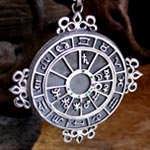 |
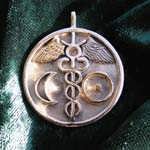 |
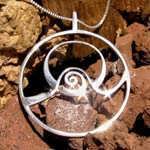 |
| Personalized
Talisman |
Alchemical
Wedding Talisman |
Abundance
pendant |
Talismans and AmuletsBy the Artist - David Weitzman |
||
Other magical associations, such as colors, scents, symbology, patterns, Kabbalistic figures, can also be integrated in the creation of a talisman. However, they should be in synchronization with the elemental or planetary force selected to represent the talisman. It is also feasible to augment a personal touch to the talisman through adding a verse, inscription, or pattern. These inscriptions can be magical emblems, bible verses or sonnets.
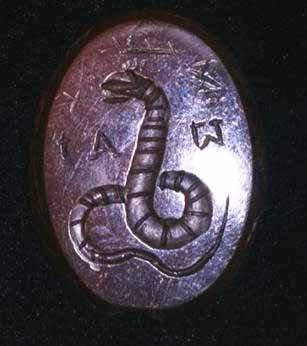
Talisman and amulets were prescribed by medical practitioners in the medieval period. The utilization of such charms and prayers (referred to a Empirica in authoritative medical texts) were 'rarely a treatment of choice' due to the inability of such treatments to be properly justified in the realm of Galenic medical teachings. Yet, the use of amulets was typically considered acceptable due to the large number of references to their use in the medical literature overall.
Through drawing on these references as a guide, Gilbertus (c. 1180 - 1250), for example - an English physician - writes of the necessity of using a talisman to ensure conception of a child. He describes the process of producing the talisman, which includes writing words, some unable to be interrupted, some biblical, on a parchment to be hung around the neck of the man or woman during intercourse.
In antiquity and the Middle Ages, most Jews, Christians and Muslims in the Orient believed in the protective and healing power of amulets or blessed objects. Talismans used by these peoples can be broken down into three main categories. The first are the types carried or worn on the body.
The second version of a talisman is one which is hung upon or above the bed of an infirm person. The last classification of talisman is one with medicinal qualities. This latter category of item can be further divided into external and internal. In the former, one could, for example, place an amulet in a bath.
The power of the amulet would be understood to be transmitted to the water, and thus to the bather. In the latter, inscriptions would be written or inscribed onto food, which was then boiled. The resulting broth, when consumed, was assumed to transfer the healing qualities engraved on the food into the consumer.
Jews, Christians, and Muslims have also at times used their holy books in a talisman-like manner in grave situations. For example, a bed-ridden and seriously ill person would have a holy book placed under part of the bed or cushion.

Amulets are plentiful in the Jewish tradition, with examples of Solomon era amulets existing in many museums. Due to proscription of idols, Jewish amulets emphasize text and names - the shape, material or color of an amulet makes no difference.
The Jewish tallis (Yiddish-Hebrew form; plural is tallitot), the prayer shawl with fringed corners and knotted tassels at each corner, is perhaps one of the world's oldest and most used talismanic objects. Some believe it was intended to distinguish the Jews from pagans, as well as to remind them of God and Heaven. An incorrect conjugation of the plural form (with Ashkenazi pronunciation), "tallisim," is very close to the term "talisman;" however, this is an incorrect etymology as the word talisman is of Greek origin.
A little-known but well-worn amulet in the Jewish tradition is the kimiyah or "angel text". This consists of names of angels or Torah passages written on parchment squares by rabbinical scribes. The parchment is then placed in an ornate silver case and worn someplace on the body.
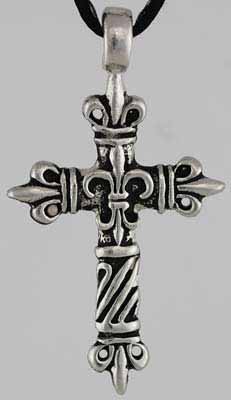
The Catholic Church, and Christian authorities in general, have always been wary of amulets and other talismans. However, the legitimate use of sacramentals, as long as one has the proper disposition, is encouraged in traditional Christianity. For example, the crucifix is considered a powerful apotropaic against demons and fallen spirits, and rosaries or St. Christopher medals are frequently hung on rear-view mirrors of vehicles in Christian cultures as a way of invoking God's protection during travel. Lay Catholics are not permitted to perform exorcisms but they can use Holy water, blessed salt and other sacramentals such as the Saint Benedict Medal or the Crucifix for warding off evil.
Crucifix
The Crucifix is one of the key Sacramentals used by Catholics and has been used to ward off evil for centuries. The imperial cross of Conrad II (1024-1039) referred to the power of the cross against evil. Many of the early theologians of the Catholic Church made reference to use of the sign of the Cross by Christians to bless and to ward off demonic influences. The crucifix is still widely used as an talismanic sacramental by Christians. In Christian culture, it is considered to be one of the most effective means of averting or opposing demons, as stated by many exorcists, including the famous exorcist of the Vatican, Father Gabriele Amorth.
Medals
A well-known amulet among Catholic Christians is the Saint Benedict Medal which includes the Vade Retro Satana formula to ward off Satan. This medal has been in use at least since the 18th century and in 1742 it received the approval of Pope Benedict XIV. It later became part of the Roman Catholic ritual.
Scapulars
Some Catholic Sacramentals are believed to defend against evil, by virtue of their association with a specific saint or archangel. The Scapular of St. Michael the Archangel is a Roman Catholic devotional scapular associated with Archangel Michael, the chief enemy of Satan. Pope Pius IX gave this scapular his blessing, but it was first formally approved under Pope Leo XIII. The form of this scapular is somewhat distinct, in that the two segments of cloth that constitute it have the form of a small shield; one is made of blue and the other of black cloth, and one of the bands likewise is blue and the other black. Both portions of the scapular bear the well-known representation of the Archangel St. Michael slaying the dragon and the inscription "Quis ut Deus?" meaning Who is like God?.
Holy Water
The Catechism of the Catholic Church (number 301) specifically refers to the use of Holy water for "protection from the powers of darkness". Catholic saints have written about the power of Holy water as a force that repels evil. Saint Teresa of Avila, a Doctor of the Church who reported visions of Jesus and Mary, was a strong believer in the power of Holy water and wrote that she used it with success to repel evil and temptations.
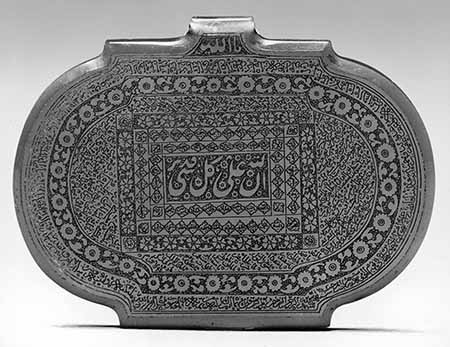
A talisman is any object that is imbued with protective powers, and all cultures have manifestations of such objects. In the world of Islam, they bear Qur'anic inscriptions as well as images of prophets, astrological signs, and religious narratives. Many Muslims believe that an object that is inscribed with the word God (Allah) will protect the person who reads, touches, or sees it and that the word of God has the power to ward off evil. The surface of a talismanic object can be covered with prayers, signs, numbers, and decorative motifs, and the object is carried in a pocket, or rolled and placed in an amulet case; some talismans are worn as clothing.
The most efficacious talismans are those that are inscribed with prayers that evoke the name of God and the Prophet Muhammad and his companions. The ninety-nine names of God, verses from the Qur'an, and sayings of the Prophet Muhammad (hadith), for example, are appropriated and regenerated into texts that are meant to be good omens.
Talismans that contain inscriptions with the names of prophets and religious figures have the power to protect an individual from hardship and danger by acting as conduits between these holy figures and anyone carrying the talisman. This is also true of devotional manuals by religious leaders (shaikhs) with passages stating that whoever reads them will be protected from demons and supernatural beings (jinn). The written story about a prophet can be protective as well, with pictorial representations of that prophet and of the omens associated with him.
The representations of certain prophets are more efficacious than others, with Solomon's as the most powerful of all. Solomon had the ability to talk to animals and supernatural beings (jinn), and was renowned for his wisdom; Bilqis, Queen of Sheba, was converted to monotheism by witnessing that wisdom.
The Qur'an states Solomon's authority in a number of verses (Qur'anic verse 27:17), and his apotropaic seal, a six-pointed star or hexagram, occurs on many surfaces, such as a wood panel, a blade, and a scroll.
Many other religious narratives also carry talismanic powers. The story of the miracle of the seven sleepers of Ephesus (ashab al-kahf, or "people of the cave"), which is the subject of a chapter in the Qur'an (Surat al-Kahf), has particular powers for many Muslims. The act of reciting the story of the seven Christian men and their dog Qitmir who, fleeing persecution by the emperor Decius (r. 249-51 A.D.), found a cave and slept for several hundred years, protects the reader from harm, just as the seven sleepers and their dog were protected all those years.
Images of the Prophet Muhammad's cousin cAli ibn Abi Talib and those of Imam cAli, son-in-law of the Prophet Muhammad, with his two martyred sons Hasan and Husayn, also carry apotropaic properties. Ali's miraculous sword (Dhu'l fiqar) becomes a relic and talismanic object in Islam, and is represented across various media.
Talismans not only shield but guide their wearers; they are objects that reflect occult practices. Amulet cases, mirrors, boxes, weapons, talismanic shirts, or banners are capable of shielding a person or group of people from the forces of evil. When a person is confronted with an ethical dilemma, all he needs to do is consult the Qur'an or one of these objects for guidance.
These imbued objects are also used as tools for scientists or as cures prescribed by physicians for various ailments. The cAbbasids (r. 750Ð1258) played an active role in the transmission of knowledge and science from the Greco-Roman world, and Arabic translations of medical and astrological texts were integral to Islamic court and daily life.
Historically, the stars and the Qur'an were consulted for almost every action and medical condition, and stars and talismanic objects became interconnected; and just as the stories of the prophets found in the Qur'an acted as talismans, the stars, too, would guide a person on his/her journey in this life and the afterlife. Eventually, elaborate horoscopes and a science of letters that broke down the ninety-nine names of God (ilm al-huruf) to their individual letters were created at court to predict whether a ruler was to have an auspicious reign. Sometimes these letters can be found on the clasp of a casket. The objects discussed here demonstrate the ways in which science, magic, and religious belief work together to endow objects with talismanic powers and protect individuals from harm.
Talismans that contain inscriptions with the names of prophets and religious heroes have the power to protect an individual from hardship and danger by acting as a conduit between the two. - Yasmine Al-Saleh - Harvard University
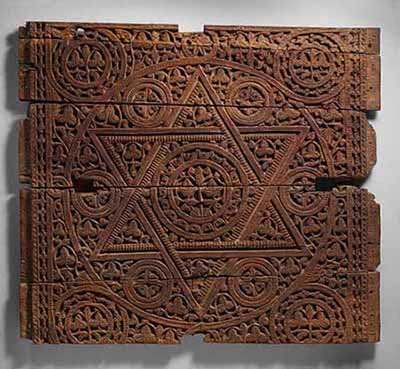
Talismans are not exclusive to portable objects. In the following example, the Seal of Solomon (a hexagram) is depicted on a carved teakwood panel from cAbbasid Iraq. Unfortunately, the actual architectural edifice it came from remains a mystery. Yet it evokes the ways in which talismans are used on architectural surfaces. Like objects, a talisman protects a city, mosque, palace, or any edifice from unknown harm, be it a scorpion, a snake, a supernatural being, or an enemy. In addition, the Seal of Solomon seen here, as well as images of animals such as lions, snakes, and scorpions, were commonly used to protect buildings and their inhabitants from harsh weather and evil spirits.
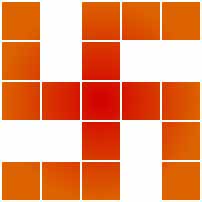
The swastika, one of the oldest and most widespread talismans known, can be traced to the Stone Age, and has been found incised on stone implements of this era. It can be found in all parts of the Old and New Worlds, and on the most prehistoric ruins and remnants. In spite of its antiquity, and the assertion by some writers that it was used by the Egyptians, there is little evidence to suggest they used it and it has not been found among their remains.
It is unknown whether the correct form stands with its arms turned to the left, or to the right. Both forms seem equally common, found both ways in various territories. On the stone walls of the Buddhist caves of India, which feature many of the symbols, arms are often turned both ways in the same inscription.
During the tumultuous Plains Indians troubles in mid-19th century America, the Lakota Tribe adopted the Ghost Dance ritual, created by a Paiute Indian living in northwestern Oregon. Black Elk, the great Lakota Holy Man, received instructions on how to create a talismanic shirt that would protect the Lakota from the Greedy White Man's bullets. Tragically, the shirts failed to offer the Lakota any protection.
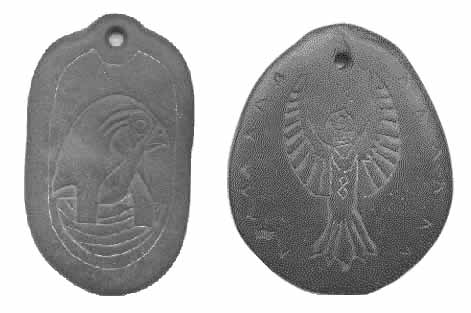
The two amulets above were found in an ancient burial tomb in close proximity to an ancient pyramid located in the Mississippi River Valley. The image on the left looks much like the Egyptian God Horus - resurrection and rebirth. The winged image on the right speaks of the alchemy of consciousness in "time" or "ascension".
According to legend, the amulets were found in the burial tomb of a High Priest and Priestess who inhabited that ancient city well over 30,000 years ago. They were laid to rest together so they might share the same union in the after world that they shared on the Earth plane. The strength of their union and concurrent time of death was indicated by the symbolic placement of their hands, one holding the other's.
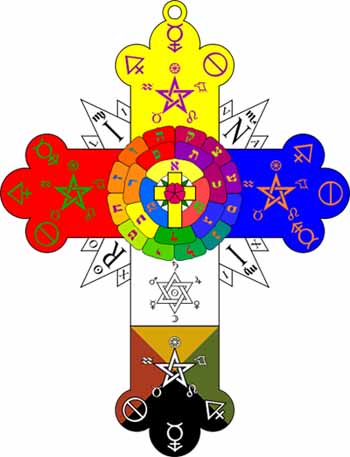
According to the Hermetic Order of the Golden Dawn, a magical order active in the United Kingdom during the late-19th and early-20th centuries, a talisman is "a magical figure charged with the force which it is intended to represent. In the construction of a talisman, care should be taken to make it, as far as possible, so to represent the universal forces that it should be in exact harmony with those you wish to attract, and the more exact the symbolism, the easier it is to attract the force."
